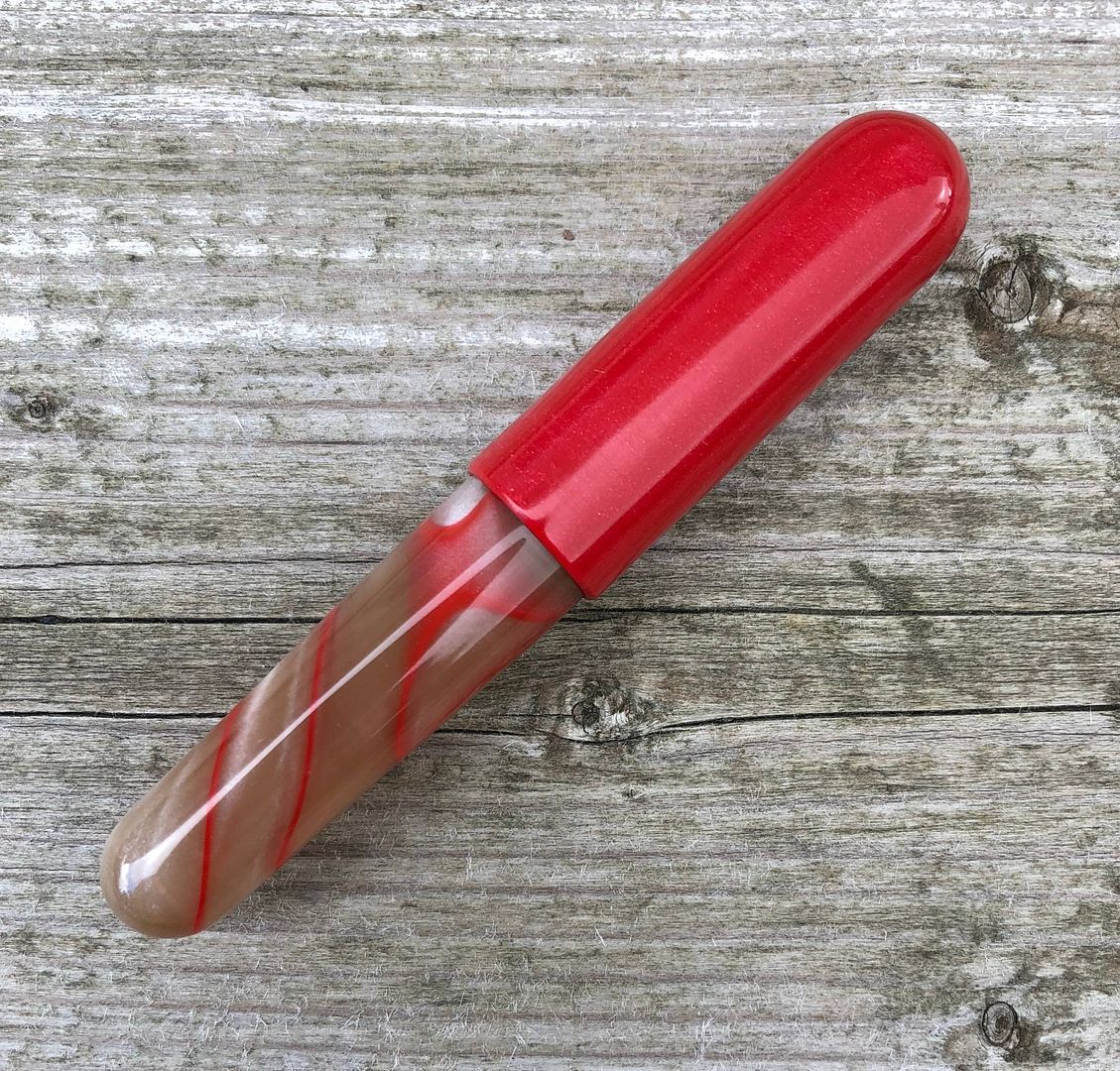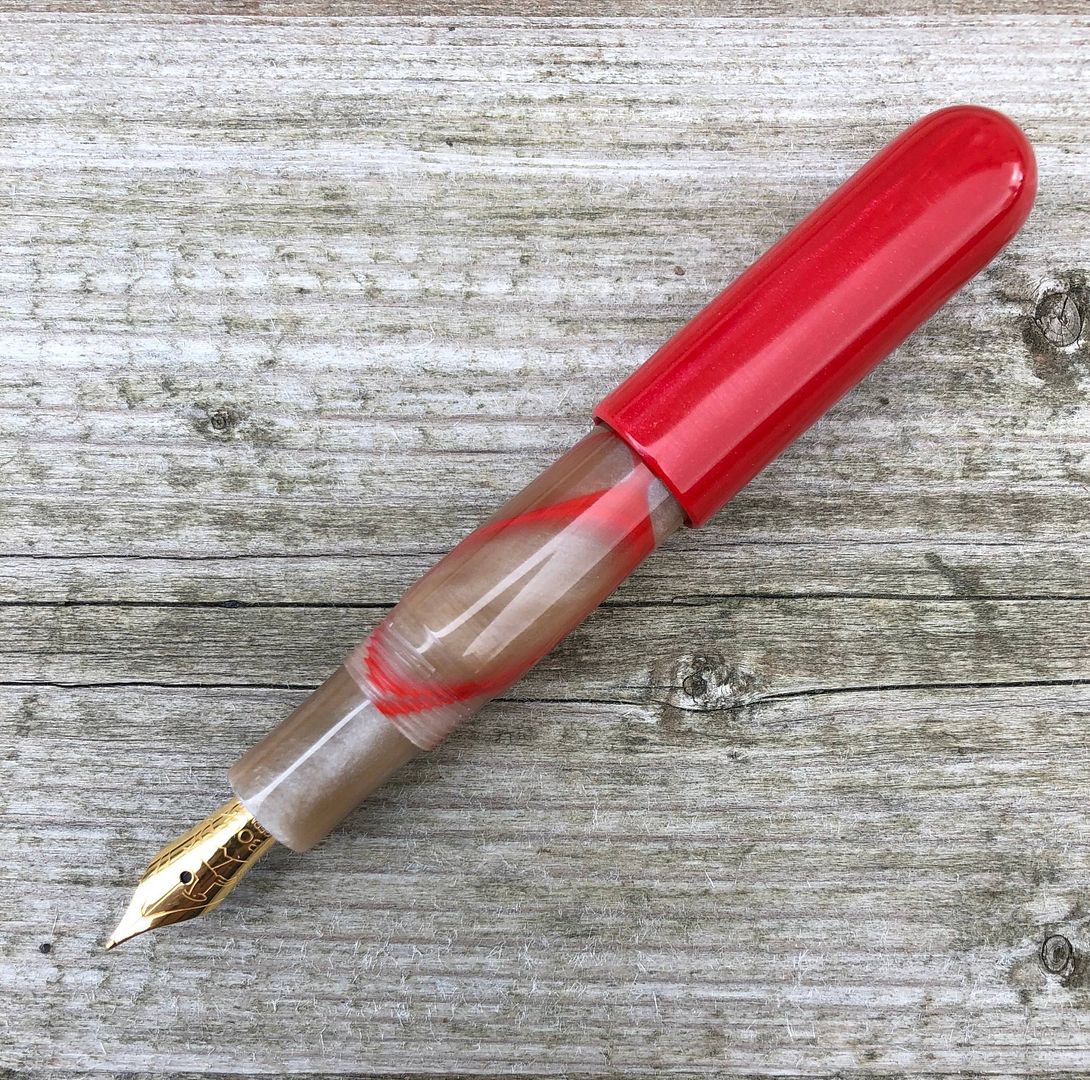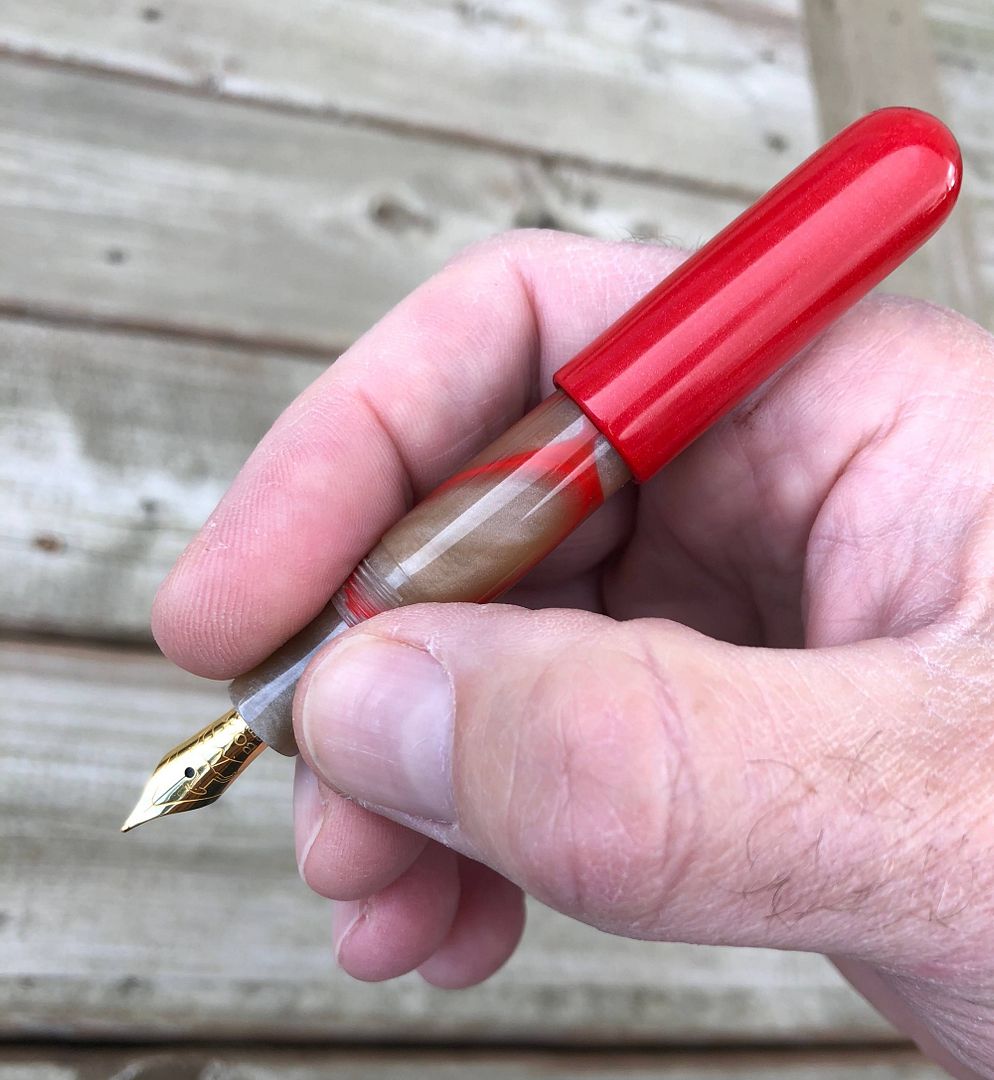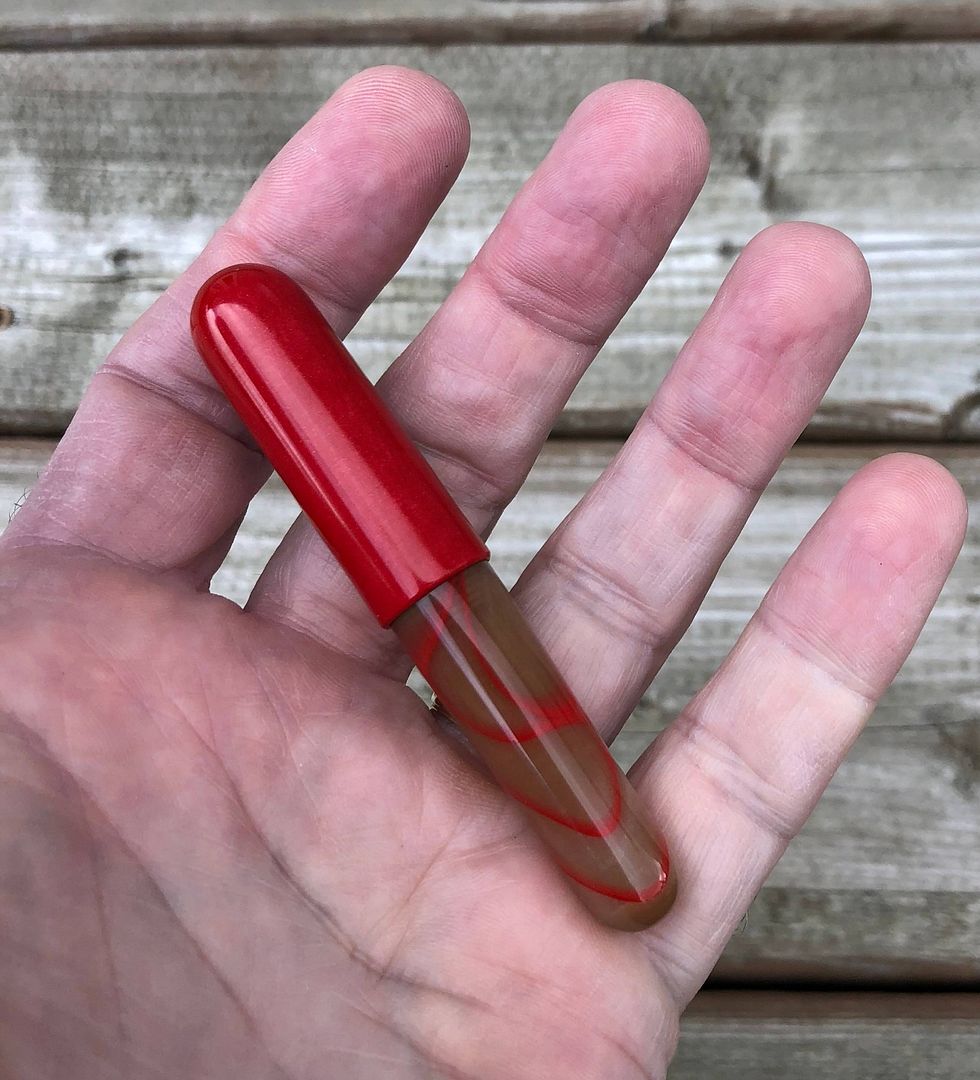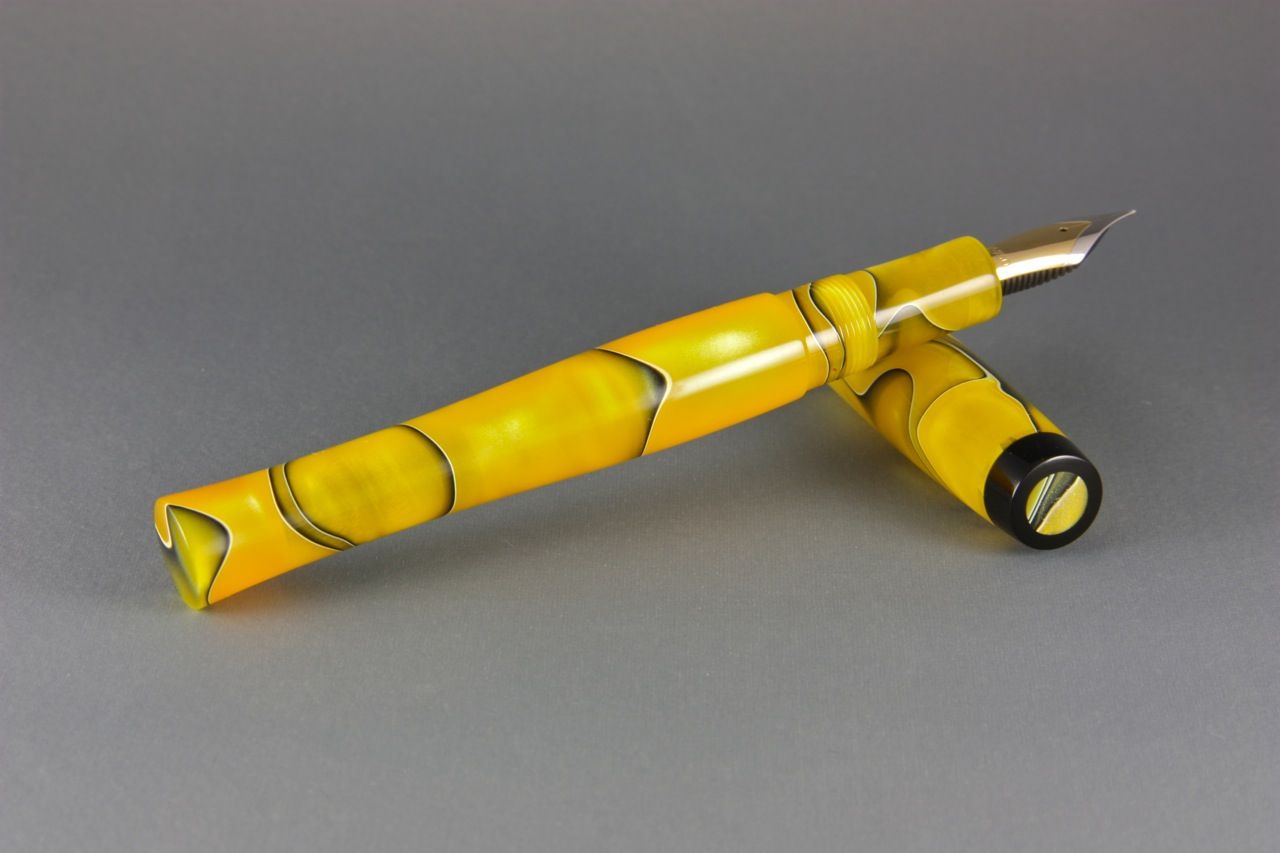I have been making and selling fountain pens for a number of years now, and while most of these pens go off to people who are as fountain pen crazy as I am, some find their way to folks who are not quite so used to the tricky aspects of fountain pen use. So, I thought maybe it was about time that I put together a 'users' guide' to go through some of the basics on the use and care of the fountain pens that I have made (and, for that matter, of the ones that I didn't make).
Fountain Pen Parts
(Will add picture when I get a chance to make one)
Filling Your Fountain Pen with Ink
Virtually all of my fountain pens are designed to use ink cartridges or an ink converter. The type of cartridges that my pens will take is the standard short international ones (and most of them also the Waterman long cartridges). There are an enormous number of brands that make standard cartridges, so I will not list them all, but just be aware that certain pen companies make cartridges that only fit their pens. That would include such brands as Cross, Sheaffer, Lamy, and a few others. When installing a cartridge, push it firmly onto the nipple inside the base of the grip section. Often you will hear a 'pop' or feel it give as it pops into place. Wait a few minutes for the ink to flow into the nib and feed, and you are ready to go.
If the ink does not flow into the nib and feed as it should, and the nib stays dry, you can try gently shaking the grip section to push the ink through the feed. You can also try wiping the nib itself with tissue or paper towel, as this may wick the ink though the slit in the nib. If all else fails, you can try dipping the ink in water so that it is wet inside, and should then need no priming. Wipe the nib several times until the ink flowing through darkens up enough to use, and you are good to go.
A converter is essentially a cartridge with a built in piston system to allow you to fill it with ink from a bottle. By twisting the knob on the converter, the piston moves up and down inside the barrel of the converter. To fill the converter with your choice of bottled ink, you can simply pull out the converter, twist the piston close to the opening, place the opening of the converter in the ink, and twist the knob to raise the piston and pull ink into the converter. Wipe the end of the converter with some tissue or paper towel, and plug it firmly back into the pen's grip section. Wait a few moment for the ink to run into the nib and feed, and you are ready to go. Alternatively, you can leave the converter in the pen, and dip the nib itself into the ink, and twist the converter knob to raise the piston with the nib immersed, thus filling the converter. Wife the nib and feed, and you are ready, and should not need to wait, as the nib and feed should now be primed.
Many of my pens can also be used as eyedropper fillers - that is, the whole barrel can be filled with ink by eyedropper, and allowed to run through the feed as it would from the converter. The big advantage of this is an enormous ink supply that will last many, many times longer than a cartridge or converter. However, some precautions must be taken if you wish to try this. First, check with me to be sure your pen is fit for this type of fill, as not all are. Second, put a thin coat of silicone grease on the threads (and only on the threads) of the grip section where it fits into the barrel to avoid leakage. I usually apply some silicone grease (during shipping preparation) to the threads inside the grip section where the nib unit screws in, so
leaks at that site should not be a problem.
Cleaning Your Fountain Pen
Any fountain pen that gets used will need to be rinsed out from time to time. If you are using it quite regularly with the same ink in it, and not leaving it uncapped for more than a minute or so when not being used, it may not need rinsing for many months. However, there are many circumstances in which you should consider cleaning it out on a more regular basis:
- If you use it infrequently and leave it inked in between uses - the ink can slowly dry out and should be rinsed out to avoid clogging the feed.
- If you are changing inks. As inks have differing chemical properties (pH, chemical composition etc), sometimes switching inks without rinsing can cause particles to precipitate out and clog the feed. Always rinse the nib and feed thoroughly (through the grip section) before switching ink.
- If you use 'iron-gall' inks. These are becoming less frequent, so not much of an issue for the average pen user. Iron-gall inks are absolutely wonderful inks to use, as they tend not to soak through the paper as easily, and are generally permanent, but can slowly clog up a nib and feed with small particles and iron deposits. Best way to avoid this is to rinse these pens frequently (every couple weeks even).
To clean your nib and feed, simply unscrew the grip section, run cool (not cold) tapwater under the tap through the grip section's top (the threaded part) allowing the water to run through the nib and feed. Run the water this way for a good 30-60 seconds. Rinse out your converter as well, and then plug the converter into the grip section. Immerse the nib in water, and use the converter's twist knob to pull water into and push water out of the the converter, thus flushing the nib and feed. Continue this several times until no more ink residue is seen coming out the nib. Shake the excess water out of the grip section/nib/feed, and you are ready to refill.
If you suspect that the nib and feed have been clogged by long sitting with ink in them, or have dried out, you can either soak the grip/nib/feed in water overnight and try rinsing again, as this often is sufficient.
If you have been using iron-gall ink and find the ink flow slowly drying up, it is probably getting a bit clogged. You can try the above, but if it does not work, try flushing with a dilute solution of white vinegar, as the low pH can better dissolve any iron deposits.
Storage
If you are not likely to use your pen for a few weeks, it is best to remove the ink from it and thoroughly flush it out. You can then store it. If the pen is empty and flushed, it does not need to be stored tip-up.
Where to Look for Ink (I am not associated with any of these dealers, but I have used several of them):
This depends a lot on where you live. Larger cities often have a few good pen and paper shops where one can find an assortment of bottled and cartridge ink - and such dealers can usually be found by searching online for 'fountain pen stores' or 'pen shops' and such. Smaller centres unfortunately often do not have such specialty shops, and one is better off looking to online dealers. Here in Winnipeg, for example, one can buy bottles and cartridges of Waterman ink at the University bookstore, or perhaps a small selection of ink cartridges (including the Waterman long cartridges) and bottles (of Parker Quink) fountain pen ink at Staples. Apart from those, there is very little locally.
Here are just a few links to pen and ink dealers in Canada who do online retail (if you know of others, I would be happy to add them):
-
knightswriting.ca (Aurora, Ontario)
-
stylo.ca (Quebec)
-
stylusfinepens.com (Edmonton)
-
wonderpens.ca (Toronto)
And here are some of the online suppliers in the U.S (again, would be happy to add to this list):
-
bromfieldpenshop.com
-
dalyspenshop.com
-
fahrneyspens.com
-
fountainpenhospital.com
-
gouletpens.com
-
hisnibs.com
-
nibs.com
-
paradisepen.com
-
vanness1938.com
If you are looking for pen and ink shops to visit in any particular city, have a look at
glennspens.com - an interesting blog, and excellent resource for finding stores in any given city.
Cautions
There are a few thinks to avoid in order to keep your pen working well:
-avoid storing the pen for long periods of time as noted above.
-avoid blunt trauma to the nib tip - it bends the tines and puts them out of alignment, rendering the pen scratchy, or worse - unusable (most often this can be fixed by someone experienced in nib servicing)
-avoid unscrewing the nib unit from the grip section - all of my pen have nib units that screw into the grip section. While this does allow for swapping out nibs, the torque used to unscrew and screw in nib units often throws the tines out of alignment, necessitating a bit of adjustment to avoid a scratchy nib.
-avoid switching inks without rinsing out the nib (see above) - different inks have different chemical compositions, and sometimes the wrong combination will cause particles to precipitate out of the ink and clog the nib and feed.
-avoid leaving the pen uncapped if you pause in writing, as the nib can often dry out fairly quickly (I usually cap my pen if I am likely to pause in my writing for more than a minute or so. Maybe even less with some inks).
-avoid dropping the pen from extreme heights, boiling it, or running it over with your car.
Troubleshooting:
- Scratchy nib: It shouldn't be, as I write-test, smooth and tune all my nibs before they go. However, twisting the nib, dropping it, or other trauma may put the tines of the nib out of alignment. I can help with that - feel free to contact me. If it a very recent purchase and not an accidental thing, I will most likely fix it up with no charge. Otherwise, I usually charge $25-$35 for nib work. Or, if you want to get a bit adventurous, and do it yourself (I think every fountain pen aficionado should be able to do a bit basic nib work), have a look at my
primer on nib work here.
- Ink will not run into the nib when I plug in the converter or cartridge: See the 'Filling Your Fountain Pen With Ink' section above. The nib and feed often need to be 'primed' or filled with ink (or water) in order to allow the capillary effect to bring the ink to the tip.
- 'false starts' and 'skipping' - may mean a nib that is too dry or whose tipping needs further smoothing. If this is an issue right away, I'd be happy to have a look. If this is an issue later on, my nib work charge will probably apply - but either way, I'm always happy to try to get a nib going.
- Ink flow slowly drying up: See the 'Cleaning your Pen' section above.
Well, that's about it for now. Enjoy the pen!
Ken
